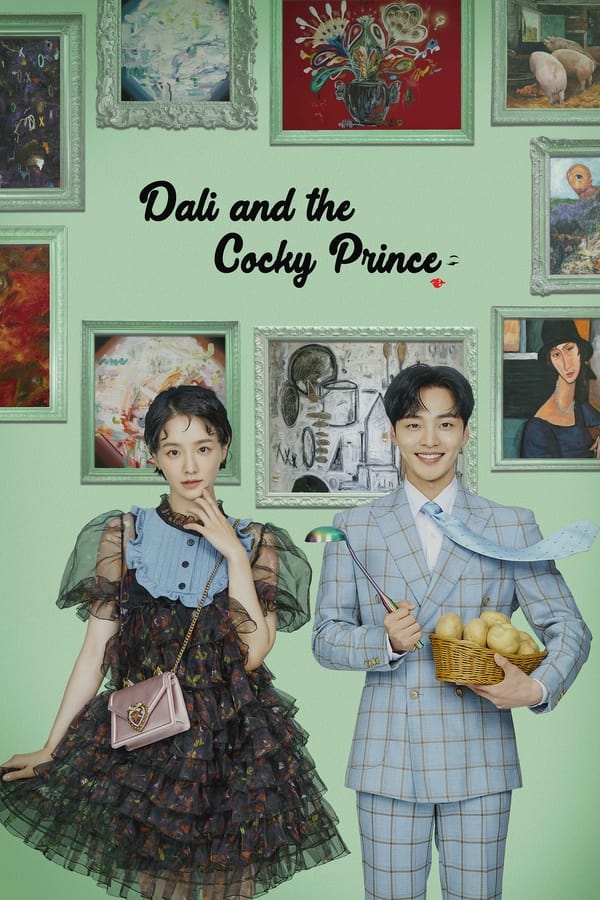Dali and the cocky Prince
“Dali and the Cocky Prince” delivers a fresh take on the classic opposites-attract trope, combining romantic tension, comedic misunderstandings, and a dash of social commentary. At its heart, the film explores the unlikely romance between two people from wildly different backgrounds—Jin Moo-Hak, a self-made businessman with little formal education but exceptional business acumen, and Kim Da-Li, an art-loving intellectual from an elite family who struggles with the more practical aspects of life. Through its engaging characters and a quirky storyline, the film invites viewers to consider deeper themes of social class, wealth, and the value of culture.
The plot begins with an intriguing set-up: Jin Moo-Hak is the second son of a family that turned their modest pork bone stew restaurant into a global franchise, Dondon F&B. Despite his lack of formal education, Moo-Hak has an uncanny talent for making money, demonstrating sharp instincts and a drive for success. On the other hand, Kim Da-Li is a refined, cultured woman—fluent in seven languages, a visiting researcher at an art gallery, and the sole heir to her prestigious family. Her upbringing, while privileged, has left her sheltered in some respects, particularly in more practical matters like household chores. It’s clear from the outset that these two characters operate in different worlds.
Their first meeting is an amusing and heartwarming encounter, setting the stage for what becomes a playful, sometimes chaotic romance. Unaware of each other’s backgrounds, Moo-Hak and Da-Li start developing feelings for one another, and the film does an excellent job of balancing this budding romance with moments of humor. Their personalities clash in delightful ways—Moo-Hak’s pragmatic, often blunt approach to life contrasts sharply with Da-Li’s idealism and sophistication. This contrast generates much of the film’s charm, as their differences create both conflict and attraction.
As the story progresses, the film introduces a central plot point that brings the characters back together: the financial trouble of an art gallery. It’s here that the film subtly weaves in social commentary, addressing the often overlooked struggle of maintaining artistic and cultural institutions in a world driven by profit. The art gallery, which is on the brink of bankruptcy, becomes a symbol of this struggle. Da-Li’s attachment to the gallery and her dedication to preserving its legacy stand in stark contrast to Moo-Hak’s more transactional view of the world. He sees the gallery’s financial instability as an obstacle to be overcome, while she views it as a cherished piece of cultural heritage that must be saved.
Their reunion, now as the rich but unpolished son of a successful business family and the elegant but financially struggling daughter of an aristocratic family, adds layers of complexity to their relationship. The film uses this tension to explore the dynamics of class, wealth, and privilege in modern society. While Moo-Hak’s family fortune is built on hard work and entrepreneurship, Da-Li’s family wealth is steeped in tradition and high culture. This juxtaposition raises interesting questions about the value of art and intellect versus material wealth and business acumen. In many ways, the film challenges the audience to think about what constitutes true success and happiness.
“Dali and the Cocky Prince” excels in its character development. Moo-Hak, despite his cocky and often brash exterior, is a deeply empathetic character who is shaped by his experiences of coming from nothing. His insecurities, particularly his lack of formal education, are handled with sensitivity, allowing the audience to see his vulnerability beneath the surface. His journey throughout the film is one of self-acceptance and growth, as he learns that there is more to life than just making money.
Similarly, Da-Li’s character is beautifully nuanced. While she initially appears as the epitome of grace and intellect, her struggles with basic life skills and her financial naivety make her relatable and endearing. Her love for art and her sense of responsibility toward the gallery add depth to her character, highlighting her dedication to preserving beauty and culture in a world that seems increasingly indifferent to such values. Her journey in the film is one of stepping outside her comfort zone and confronting the harsh realities of life, which she has largely been shielded from due to her privileged upbringing.
The chemistry between the two leads is palpable and carries much of the film’s emotional weight. Their interactions are filled with witty banter, playful teasing, and moments of genuine vulnerability. As their relationship evolves, the film moves beyond the initial humor of their differences to explore deeper emotional connections. The romance between Moo-Hak and Da-Li feels organic, as they each learn from the other and grow as individuals.
Visually, “Dali and the Cocky Prince” is a treat. The film’s production design does an excellent job of highlighting the contrast between the two characters’ worlds. Moo-Hak’s business empire is portrayed through sleek, modern settings, while Da-Li’s life is imbued with the elegance and charm of art galleries and stately homes. The cinematography captures both the grandeur of their respective environments and the intimacy of their growing relationship.
Where the film stumbles slightly is in its pacing. There are moments where the story lags, particularly in the middle act, where the focus shifts more heavily to the financial woes of the gallery. While this plot point is important thematically, it occasionally detracts from the central romance, causing the narrative momentum to falter. However, the film quickly regains its footing in the final act, delivering a satisfying and heartwarming conclusion.
In conclusion, “Dali and the Cocky Prince” is a delightful and thought-provoking romantic comedy that offers more than just light-hearted entertainment. Through its well-crafted characters, it explores themes of class, culture, and the pursuit of happiness, all while delivering a charming love story. With strong performances, sharp writing, and a visually appealing aesthetic, the film strikes a balance between humor, romance, and social commentary, making it a must-watch for fans of the genre.

